
| www . ICEVI - Europe . org |  |
Volume 16 number 4, December 2010

In the September newsletter I have already informed you about the items which were discussed in the Board meeting in August in St. Petersburg.
The past few months have passed quietly, although the 4th East European Conference took place in St. Petersburg. The theme of this conference was scientific and practical aspects of the education of people with visual impairments: Problems and Prospects.
In the newsletter you will find the contribution of amongst others Knut Brandsborg: Recognition of autistic behaviour in the blind child at an early age.
Shortly after we had the 5th ICEVI Balkan Conference in Zagreb, Croatia. The theme was a Scientific Professional Conference: New competencies for Future Challenges in Europe. You will find a summary in this newsletter.
The EXCO meeting of ICEVI and the General Assembly took place in London from 2 – 4 December. The meetings were necessary because of the cancellation of the ICEVI Conference in Thailand and therefore the General Assembly also did not take place.
During both meetings the usual items were discussed: approval of the annual report 2009 and the budget 2011.
Also the principal officers were appointed.
After 10 years and with a huge applause Larry Campbell resigned as president of ICEVI.
His successor is Lord Colin Low. Jill Keeffe and Nandini Rawal, treasurer, were re-appointed.
Hans Welling filled the vacancy that was created by the resignation of Harry Svensson.
It is important to mention that the upcoming ICEVI World Conference will take place in 2012. The precise date and place are not yet known. Consultation about this is taking place with WBU, because the aim is to jointly work together with them on the conference.
We are almost at the end of 2010.
A year with new possibilities. The Board members will concentrate on the future of ICEVI-Europe during the meeting in May 2011.
Up till now there is every indication that in September 2011, the International Masters in Education of the visually impaired will start at the University of Groningen in the Netherlands. It is expected that the final information on this will be published in January - so important developments are on the way.
Herewith I would like to wish you happy and inspiring holidays.
For 2011 I wish you good health and a happy gathering with your nearest and dearest.
For information I refer you to the website of ICEVI www.icevi.org
On behalf of the Board of ICEVI-Europe,
Hans Welling, Chairman
www.icevi-europe.org
The Conference was hold by The INSTITUTE of SPECIAL PEDAGOGICS and PSYCHOLOGIES, St.-Petersburg (http://wallenberg.ru) and under the support of ICEVI-Europe (www.icevi-europe.org) . We are following the tradition of holding the every year conferences within the limits of the project “XXI century – All Over the Open Century”.
The Conference was devoted to the 80 anniversary from the date of a birth of Valentina A. Feoktistova - the outstanding teacher and psychologist in the field of vocational education, is widely known in Russia and abroad.
Valentina Feoktistov – the scientist, the author of many books on tiphlopedagogist, one of the latest books is presented to communicative skills of visually impaired children «Development of dialogue skills of visually impaired children», 2005.
Participants of the conference were welcomed by the rector of Institute - Professor Lyudmila Shipitsyna. With a greeting to guests and participants of conference the President of ICEVI-Europe Mr. Hans Welling has addressed, he has noticed: “It is world renowned the heritage left by the Russian scientists: Alexander Lurija, Lev Vygotsky, Valentina Feoktistova These are scientists-experts, whose experience we can always are guided in our work with people with special needs”.
One of the keynote speakers was Mr. Knut Brandsborg from The Huseby Resource Center, Oslo, Norway (www.ks-huseby.no). Не has mentioned theme very interesting and a little studied in East-European region: “Blindness, autism-like difficulties and autism: what is the connection?”
The Conference has collected more than 240 participants from 10 countries of the East-European region.
The conference program has predetermined also the cultural program. Participants of conference have visited the Hermitage, have made cruise over the rivers and channels, had a rest at Imperial Hermitage Theater.
We thank participants of the conference for interesting reports.
We express deep gratitude to organizing committee for conference preparation.
Many thanks to students-volunteers for the help and the humanitarian relation.
The review has prepared by
Liliya Plastunova, Regional Chair – E-EC
plastunova@yandex.ru
5th ICEVI Balkan Conference took place in Zagreb, Croatia on October 20 - 24, 2010, and was organized by all the major participants in education and rehabilitation of the blind and low vision people in Croatia. Name of the conference was “New Competencies for Future Challenges in Europe” regarding Visually impaired population as well as population who have additional disabilities (MDVI) and the topics were:
The aim of the conference was to stimulate a critical discussion about different approaches and different experiences in education, rehabilitation and implementing various programs in different countries regarding the education and rehabilitation of the VI and MDVI population from their birth to their adult age and employment possibilities.
The main goal of the conference was to explore and share knowledge and experience in working with Vi and MDVI population, and what curriculums, frameworks and educational approaches there are across Balkan Countries.
We gathered 92 participants from 13 countries and through 34 oral presentations, 6 workshops, 3 visits to different Centers, we fulfilled the aim and the goal of the conference and also contributed to the better networking throughout the region.
We are glad that we can announce that next ICEVI Balkan conference will be held in Romania in 2012.
Darija Udovičić Mahmuljin, Organization Committee Chairman
Marijana Konkoli Zdešić, Contact Person for Croatia
Assoc. prof. Mira Tzvetkova-Arsova, PhD, Sofia University “St. Kliment Ohridsky”, Faculty of Primary and Preschool Education, Department of Special Education, e-mail: miratz@abv.bg
Dear Ladies and Gentlemen, dear colleagues and friends,
First of all allow me to express my deepest satisfaction of the fact that this is the Fifth ICEVI Balkan conference that gathers us together today and that we all are a part of the good tradition of organizing conferences on a Balkan level.
Throughout the years of starting the first Balkan conference in 2000 in Varna, Bulgaria, I personally made lots of new friendships during the Balkan conferences, lots of good professional contacts and learned a good deal of what is going on in the field of education of visually impaired in the neighboring countries. Even now in this conference room, I see many familiar faces, but also many new faces.
Conferences like this one always have two parts:
The first part is important, because it gives us a sense of certainty, of continuance, of old, but good traditions.
The second part, however, is also very important, because it provides the element of surprise, of what we do not know, but can expect.
Good traditions together with innovations are the key-ingredient of every successful conference.
In this row of thoughts I am also planning to offer you today something old and something new.
The old part: I will talk to you a little bit about the past experience we have in the education of visually impaired students on the Balkans.
The new part: I would like to present to you a short overview of what is the current situation in terms of education of visually impaired and visually impaired multiply disabled in our countries.
Allow me to remind you on the year that we all know about: 1784 was the year of official opening of l'Institution des Enfants Aveugles (Institution for Blind Children) in Paris, France – the first educational establishment for the blind in Europe and in the world. The man behind this achievement was Valentin Hauy.
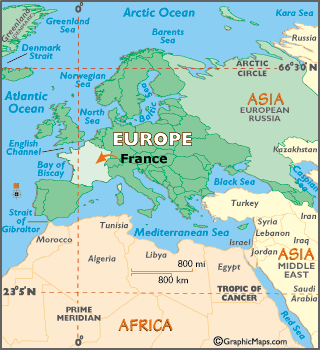
The first special schools for blind on the Balkans were opened, however, much later due to various economic, political and other reasons.
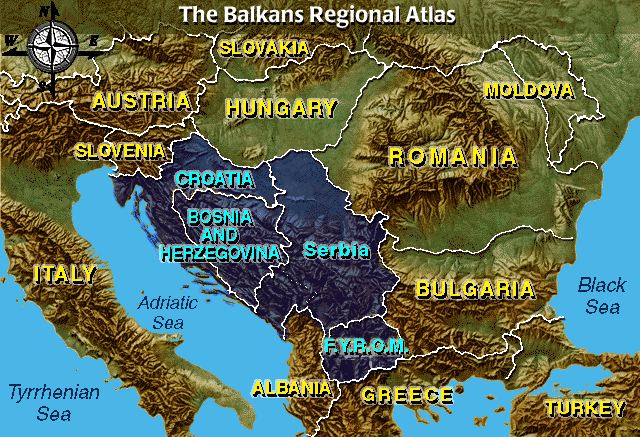
Starting at about the end of the XIX century, going through the years 1900, 1905, 1906 etc., we can say that most of the Balkan countries opened their first special schools for visually impaired within the first 4 decades of the XX century. Some special schools were opened, however, in more recent time.
On the following photos we can see some of the special schools for visually impaired on the Balkans.

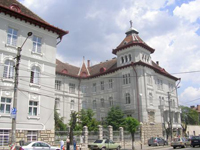
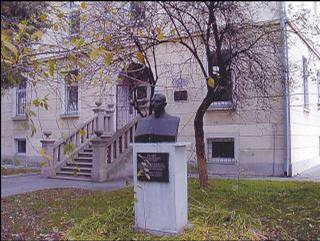
What characterized the education of visually impaired at the beginning?
Why is it important to be aware of our past?
Because only when we know where we started from and how, we can know where to go to and how to continue our successful work in the future.
Besides, only when we know what our past was, we can see and understand all the changes that occurred throughout the years, and we can realize how far we went, how much we achieved and how much better our current work is.
I will not dare to talk about everything that the contemporary situation in our countries includes. Simply because I know that in each country a lot is done, a lot of new good ideas and good practices are implemented. I will, however, try to outline some important trends that characterize our current work on the Balkans and the directions we follow. These trends are in accordance to the world trends and world best practices:
In the last 20 years almost all Balkan countries started educating students that have visual and other disabilities in a combination. Many of these students were considered uneducable for a period of time. Since late 80-s and early 90-s of last century a real growth in their education was seen. A new understanding of their needs and strengths was also adopted.
At the current moment visually impaired multiply disabled are admitted either in special schools, in regular schools, in day centers and other educational settings.
An Individual Education Plan (IEP) is developed for each student.
As the number of visually impaired multiply disabled students is growing rapidly, a special attention is given to this unique and special group of students.
Most of the Balkan countries passed recently educational laws and regulations that secure the right of education of visually impaired multiply disabled, the educational placement, the need of an individualized approach in their education, the role of the parents.
New classes and activities were included currently in the education of the visually impaired multiply disabled students as for instance: sensory integration; behavior management etc.
The 3 special programs for visually impaired: Orientation and Mobility; Low vision training; and Activities of daily living, were implemented as integral parts of the whole educational process in most of the Balkan countries. They were officially recognized as important and significant for the future independence of students with visual impairments.
In the same time more needs to be done in some of the Balkan countries in order to provide visually impaired students with really high level of instruction in all 3 special programs. For instance more attention should be given in the Orientation and Mobility on the Orientation part and the training of the remaining senses. Not enough time and attention is given to the instruction in Activities of daily living to visually impaired students integrated or included in regular schools.
Early intervention of visually impaired students is also a quite new area on the Balkans. Although there were some forms of help and support to families of young visually impaired children and the children themselves, in Bulgaria for instance the real start of early intervention was in 1992 after the ICEVI World conference in Thailand. Since then, however, a lot was done and at the current moment there is a good network of services for young visually impaired children and their families.
As my good friend and colleague Mrs. Terezie Hradilkova will talk more about early intervention in Europe in her key-note speech, I will stop here.
Integrated and inclusive education were world-widely recognized as an official educational policies especially after the Salamanca Statement and Framework for Action on Special Needs Education, developed at the World Conference on Special Needs Education in Salamanca–Spain, in 1994. The key concept in this Statement was “school for all”.
In some Balkan countries the integrated education of Visually Impaired students started as early as the 80-s of last century. In many cases it was first the special schools for blind that initiated and implemented integration into practice. Integrated education slowly turned into inclusive education. In the past 20 years the following achievements can be underlined on the Balkans:
In the same time there are still lots of problems and issues in the integrated and inclusive education of students with Visual Impairment, that need to be solved in our countries:
Special schools are important and should stay in existence even in a situation of highly developed system of integrated and inclusive education.
Why are special schools so important?
However, we have to admit that often the role of the special schools is not well understood or underestimated.
Many special schools for Visually Impaired on the Balkans already have taken their place in the school system and are often searched for help, support, educational materials, special equipment etc. by regular schools and by regular or resource teachers.
In the same time, according to my own observations, some special schools, especially those for mentally retarded students, still make attempts to reject the integrated and inclusive education.
One of the most important issues of the contemporary world is connected with the work and job, in other words with job orientation, job placement, a career. This applies both to visually impaired and to visually impaired multiply disabled.
In order to find appropriate solutions to this issue many special schools, regular schools, day centers and other educational settings working with students with visual impairments or with visually impaired with additional disabilities, started to offer job trainings.
For visually impaired the training includes besides the traditional professions as massage and some others, also: computer work, office work etc. A special emphasize is put on preparing for an interview with a potential employer; acquiring good social skills and manners, appropriate daily living skills and also orientation and mobility skills.
For the visually impaired multiply disabled many schools opened special workshops for wood work, tapestry, basket making, work with clay, knitting, souvenirs making, growing plants, teaching simple manual work – assembling, sorting etc.
All mentioned above trends changed significantly the teacher training programs, in-service trainings and all forms of preparing new professionals, offered by colleges and universities. The university curricula in many countries were changed in order to meet the new criteria, new standsrds, new requirements, and new educational policies of the contemporary time. For instance:
There are very many examples which prove well the cooperation we have developed throughout the years on the Balkans. I will give you only one or two:
Cooperation can be planned, organized and realized in many situations and in many different settings. Sometimes it is possible in conference rooms during conferences like this one, often in is realized over a cup of tea or coffee, sometimes during walks or even on the beach. On the following photos we can see some good examples:
I would like to say only few words about the future:
Thank you for your attention!
Schools and rehabilitation centres for visually impaired and blind people need a common, conceptual framework by the various disciplines working there.
Based on the classifications of the WHO (ICIDH[1], ICF[2] and ICF-CY[3]) in the last 20 years an interdisciplinary model for the education and rehabilitation to an optimal participation of visually impaired and blind people has been developed under the umbrella term Visual Profile: a method that combines professional judgments based on assessment with self-evaluations of the client, a new working definition of low vision, instruments for assessment and observation.
This method Visual Profile makes it possible to gain insight into the client’s visual problems from all perspectives: disease, disorder / body function and structure / activities / participation / environmental factors, which enables to draw up an interdisciplinary rehabilitation diagnosis.
One of the results is that people with cerebral visual impairments as well as people with ocular visual impairments have access to rehabilitation.
Please Note;
The number of participants is limited, 35 a 40 persons.
It depends on sharing rooms. There is a sequence of subscription.
Hearty welcome
Hans Welling and Gerti Jaritz
Dear readers
Thank you for all your reactions.
As you will see 72 persons have filled in the questionnaire.
The answers are clear and the many suggestions were welcome.
In our next Board meeting we will discuss the recommendations.
The conclusion so far is that the newsletter is for all of us. Please feel free to write about a theme which interests you and others to give reactions.
A lively newsletter makes reading even more interesting.
Please send your articles to Elly Aardoom ellyaardoom@visio.org
Martina Kobolkova, thank you for composing the final report.
Hans Welling, ICEVI-Europe Chairman
October 2010
72 responses (25 e-mail responses and 47 on-line responses)
| answer | on-line | all | |
|---|---|---|---|
| YES | 25 | 42 | 67 |
| NO | 0 | 5 | 5 |
| Total | 25 | 47 | 72 |
1 answer YES: Some of the issues.
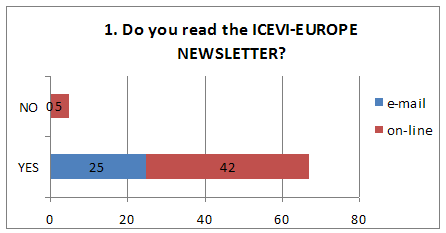
Only on-line NO’s
| Reason | on-line NO's |
|---|---|
| Length | 3 |
| Content | 2 |
| The language (only in English) | 4 |
| All of the above | 0 |
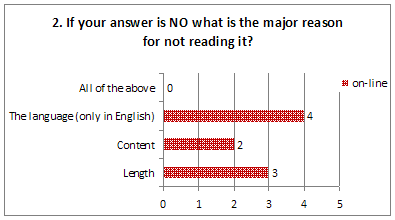
| answer | on-line | all | |
|---|---|---|---|
| 20 min | 14 | 17 | 31 |
| 1 hour | 7 | 15 | 22 |
| 2 hours | 1 | 6 | 7 |
| More than/ Less than | 3 | 6 | 9 |
| Together | 25 | 44 | 69 |
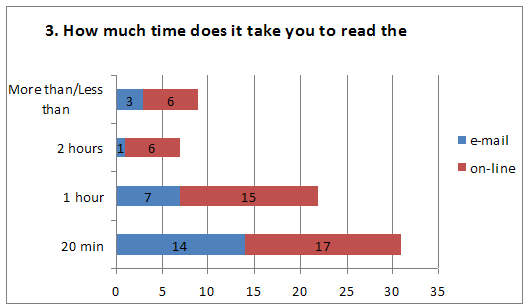
47 answers (18 e-mails and 29 on-line)
| answer | on-line | all | |
|---|---|---|---|
| YES | 14 | 33 | 47 |
| NO | 9 | 12 | 21 |
| Other | 1 | 0 | 1 |
| Not filled | 1 | 2 | 3 |
| Together | 25 | 47 | 72 |
Other: What do you mean by this question? Edit/ reviewing content
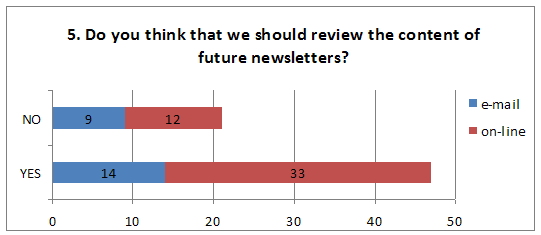
| answer | on-line | all | |
|---|---|---|---|
| YES | 20 | 40 | 60 |
| NO | 4 | 4 | 8 |
| Not filled | 1 | 3 | 4 |
| Together | 25 | 47 | 72 |
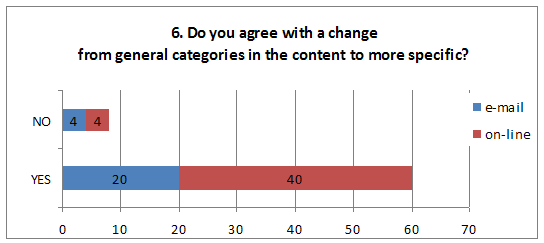
| Sections | on-line | all | |||||||
|---|---|---|---|---|---|---|---|---|---|
| YES | NO | Not filled | YES | NO | Not filled | YES | NO | Not filled | |
| 7a) Preschool period 0 – 6 years | 23 | 0 | 2 | 34 | 3 | 10 | 57 | 3 | 12 |
| 7b) School period 6 – 18 years | 23 | 0 | 2 | 39 | 2 | 6 | 62 | 2 | 8 |
| 7c) Adults | 20 | 3 | 2 | 34 | 3 | 10 | 54 | 6 | 12 |
| 7d) Elderly | 20 | 3 | 2 | 30 | 5 | 12 | 50 | 8 | 14 |
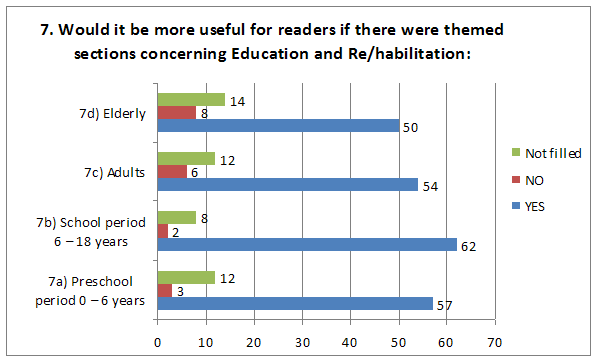
| answer | on-line | all | |
|---|---|---|---|
| YES | 22 | 38 | 60 |
| NO | 3 | 5 | 8 |
| Not filled | 0 | 4 | 4 |
| Together | 25 | 47 | 72 |
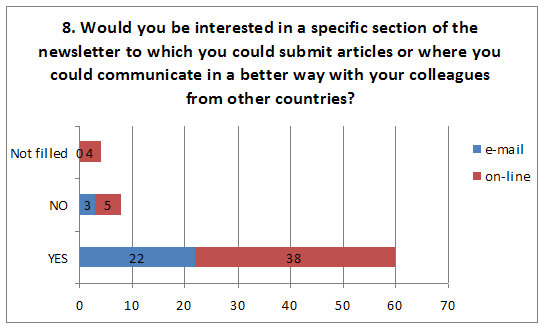
23 comments (12 e-mail and 11 on-line)
Julia Kazhevina - the director of camp tells. In 1991 Children's camp «Our House» had been organized by the Russian society of Janush Korchak. The camp purpose is the integration of children with special needs and healthy.
This year the camp has been organized in the Rostov region on the bank of Azov sea. There have arrived 110 children of the age 7 - 18 years from Russia, Tatarstan, Holland, 10 of them were visually impairment children.
Preschool visually impairment children have perfectly joined children's collective, became favourites of all camp. Children have learned to do that never did: for example, not to be afraid some water and even to jump in a pool, went boating, amused in an aquapark, have learned to argue and be on friendly terms.
Tanja Titova - mum of 7-year-old twins - shares the impressions. It was a real discover for me this summer. I have two sons 7 years old – a twin. One of them is blind with some peculiarities. I think toe numerate it will take a time – just note I always think that holidays without parents is to be possible for him after 16-18 years. But this spring I received information that there is a special camp. Nearly a week I was just getting ready to call to discuss a possibility. And then it happened the event I couldn’t believe till last moment. I was asked a bout my children in detail and then… received a positive decision. And my sons went to the camp.
Children called me almost every day. But it seems to me not because of missing me so hard but they liked a fact of new life quality – to call to parents having their own phone and to talk about themselves and events around. They called me with a problem only one time – being scared when a storm. All another questions and problems my 7 years children decided without me involving camp leaders when necessary. So it was very important lesson for the first steps on the way of getting adult and ability to know the world without parents.
My children came back very happy and satisfied. And are always asking me when they go there again. I am very glad that this summer I decided to venture on a very bold (and very important) step for me. I was very surprised many times when was preparing for our journey. I was surprised with a young age of camp leaders and their devotion to the camp. I was surprised with an arrangement. All my questions were answered in detail and every answer showed very attentive and creative approach. And I was in worry about many things – from psychological and physiological aspects of adaptation process to sanitary and hygienic organization. Everything was being thought over. Even a travel by second-class train I was worried about is not so terrible. There were many people on the platform and many children. It was horrible Moscow heat of this summer! But… I do not remember a bustle usual for such situations.
There is a feeling that the work of people in the camp makes there life. And probably the most important thing is – for the first time I forgot that my blind child is a disabled person. There were many places before where he met very tender treatment and care. As an unhappy blind boy. But here it seems to me I felt a real process of inclusion. The inclusion we are talking about so much in Russia now. But the inclusion I never met even a hint of in different child educational institutions.
So I would like to believe so hard that the camp “Our home” will be existing for a long time. And many children will be able to understand many important things for their future life.
Julia Kazhevina figara@mail.ru and
Tanja Titova Tanya-tf@yandex.ru
Day Centre for the Rehabilitation "Litlle House-Zagreb", Baštijanova 1d, 10000 Zagreb, Croatia
The Author: Viljušić Dražen, prof. Kinesiology, drazen@malidom.hr
Ria is a therapeutic dog / Labrador retriever who was in a small house passed the socialization period of a year. He then completed his education in a period of four months at the center of the Guide Dog and Mobility. From that moment Ria becomes an active participant in the therapeutic process in working with children with visual impairments and additional disabilities. Switching therapy dog in the therapeutic process has allowed the increase in the level of motivation in children as manifested in increasing levels of motor skills and abilities. Valuation levels of motor skills and ability to perform the GMFM tests every six months. Progress in the development of motor skills affect and reduce anxiety as a result of the trust that arises from the emotional connection between the child and therapy dog. Therapeutic dog therapist to establish easier communication between therapist and child and is excellent in the development of socialization among children which is of great importance in group work with children. It is of great importance to children include the integration groups in kindergartens. Such work allows easier sensory - motor development of children with visual impairments and additional disabilities since the therapy dog can experience a variety of sensory stimuli as a soft coat, a warm belly, muzzle cold, wet muzzle, hard and sharp teeth and nails, etc. realization content is done through the game which allows the realization of a number of content for children the most acceptable way. This directly manage the level of intensity and extensity therapeutic process which leads to optimization of the therapeutic process, thereby achieving the therapeutic effects of treatment. In addition, therapy dog is relaxing for children, prevent and soothe aggressive and autoagresivne excesses in behavior, calm seizures, which further allows greater opportunity provided the program content. Therapeutic process involving a therapeutic dog provides additional opportunities for improving the quality of work, and thus the effects of therapeutic work.
KEY WORDS: Therapeutic dog, children, visually impaired, kinezoiterapija
Therapeutic dog Ria, through the socialization in „Little House“ further sensitized the population of children who attend our program. Socialization lasted one year after which he underwent training for a period of three months in the center of the Guide Dog and Mobility. There he learned all the necessary knowledge and skills needed to carry out specific work programs. He is actively integrated into the therapeutic activity in „Little House“. Ria is primarily involved in kinesiotherapeutic activities although this is not the only aspect of its active and passive work. Benefits that are manifested through the integration of therapy dog in a regular therapy program are large and are manifested through the direct therapeutic results.
Primarily there is a higher level of motivation to perform set tasks (motor, sensory motor, cognitive). Through the increased level of motivation that has resulted in increased motility and work comes to an increase in the level of cognitive engagement in performing specific activities and greater focus on the motor task. It mainly depends on the complexity of the structure of each motor task but also the health status of child. Since we can regulate the level of motivation through activity which represented the socialization aspect, therapeutic activity seems pleasant and positive experience. Modulating the degree of involvement in the actual therapy dog activities we have the ability to control the level of intensity or extensity work. This represents an extremely valuable mechanism for managing the therapeutic process. Another aspect is the possibility of extending the work content. This means that we are able on better and more creative way to devise content that is customized to authentic needs and interests of each child, while they do not cause a negative attitude towards the activities offered. It certainly helps to create a relaxed and creative working atmosphere. The third aspect is the realization of the offered content through the game with child during the process that is focused not only on the therapist and his instructions, but on therapy dog who is participating in therapeutic activities. Whether individually or in groups primary goal is a positive impact on motor development.
In this parallel conduct the activities that encourage the development of communication, sensory-motor development, emotional development, socialization, empathy, extinguishing undesirable behaviors (aggressive and autoagresivnih outbursts, stereotyped movements). Realization of content within kinesitherapeutic treatment may be different target orientation and thus substantially different.
One of the possible modalities is the implementation of the motoric games that can be carried out in groups or individually, and as such can be of competitive character. Race games are of great importance especially for children with special needs because they provide much needed development of competitive spirit and self-representation. Modalities for the implementation of competitive games can be a child or group of children and Ria. By the realization of these concepts, we can further contribute to increasing the quality and increasing the dynamics of the kinesitherapeutic process. As a product of competitive games, the selfawareness is emerging, for example if the activities carried out creep or running in a competitive form between children and Ria, the question of who was first to arrive, according to a rule that children say „I“, and the question are you sure that Ria is not the answer is: "No".I Motoric game is not always structured by the therapist and in this direction should be permitted and spontaneous motoric play between the dog and the child.
Usually it's a game with the ball or throwing and making some other toys, pull ropes or other items, pampering, etc. which improves the handling ability of the hand. Segment kinesiotherapeutic activities certainly valuation effects of current motor status using the GMFM- 66 & GMFM- 88 (DJ Russell, PL Rosenbaum, Avery LM, Lane M). In the testing procedure Ria is a great motivator for the performance of motor tasks or to extract maximum potential from the child. This model has proved to beextremely successful.
We use several modes of operation:
The realization of presented modalities is carried out through semistructured activity of cyclic and acyclic character:
Sports and competitive activities and games that are out of them implemented are:
The primary goal that is achieved by implementation of the presented content is the adoption of new motor skills and improving of already known (coordination, accuracy, strength), cognitive development, competitive spirit, teamwork, emotional development and empathy.
The realization of the objectives is individual and depends primarily on the health status of each child, in order to achieve the maximum potential of the child. Content is implemented through the game and a pleasant atmosphere. During the presentation of the described activities, performed as part of the kinesitherapeutic process, Ria actively works on extinguishing undesirable behaviors in particular autoagressive and aggressive outbursts. There are three ways of extinguishing autoagressive and aggressive behaviors:
The last stage is a smoothing of Ria and thus the sensory-motor activity leads to physiological reactions already described. In this way we have of aggressive outbursts through the game and competition led to the complete pacification of the child through meaningful and appropriate activity in which we induced him to listen our instructions and to focus on competition with Ria.
Looking at the therapeutic process in full therapeutic advantage of working with a dog is measured by different parameters, and the most significant is the increased level of motivation which grows with an emotional connection between the child and therapy dog. Increased levels of motivation brings greater engagement in performing given tasks, which leads to improvements in motor and cognitive status of the child. Control of the results is evaluated through the GMFM – 66 & GMFM- 88 assessment system.
A collaboration between Huseby and Tambartun Resource centres for the Visually Impaired in Norway.


A check list for early detection of autism and autism-like difficulties in small children who are born blind
As professionals in the area of visual impairment in children we received a message of concern from a preschool teacher working with a 3 year old blind child, saying: "…we are so worried. He spends a lot of time walking around and talking to himself. When we try to relate to him, he sometimes rejects us, sometimes he will have contact with us only if we are willing to listen to him talking about his fantasy persons. Can these be signs of autism? Some teachers in our kindergarten have seen similar behaviours in other children and believe that he should be diagnosed for autism. What should we do?"
The two resource centres in Norway for persons who have a visual impairment, Tambartun and Huseby, started a project in 2004. At that time we were unable to find tools that could help us answer questions like these about blind children. There were, and still are, quite a few messages resembling this one. Is there reason to be concerned about a particular blind child's development? Is this child in need of special assessments, efforts, resources or interventions?
There are several dilemmas we encounter when we are dealing with blindness and autism in children.
Being born blind may lead to some of the same types of behaviour and developmental disorders that we can see in sighted children with autism.
Even if the behaviour looks similar, the blind-born child does not necessarily have the organic condition autism. Therefore we have decided to use the term autism and autism-like difficulties in this project.
On the one hand, children who are born blind and sighted children with autism seem to have some common features. These features may have similarities in appearance, but with a different cause and purpose in the two groups.
On the other hand, to be born blind appears to increase the risk of deviant development significantly.
The unusual behaviour we frequently see in blind children may be functional. Delayed development in certain areas and uncommon behaviour may represent the way blind children develop. Some unusual behaviour may reflect typical development for blind children. The same behaviour could be a warning sign of autism in a sighted child.
A substantial part of children who are born blind have autism or develop a considerable amount of difficulties resembling autism.
A Norwegian study indicates that from 20 to 25% of the population of children born blind have problems of this kind (Brandsborg, 1993). Only 50% of all the congenitally blind children without any known neurological additional handicap born in this country from 1970 until 1985 had a normal development at the age of six. We find similar result in studies from other countries. Regardless of reason, the condition requires specific efforts.
Autism-like behaviour: behaviour or aspects of development which resemble those of sighted children with autism, but which are still within the typical range for blind children.
Autism-like difficulties: behaviour or aspects of development which are unusual and outside the typical range for blind children and which frequently imply problems for the child, however these behaviours are clearly linked to the consequences of being born blind.
Autism: the child has many behaviours and aspects of development that are clearly deviant and within the autism spectrum. The child would most likely have had serious problems of this kind even if born sighted.
The last two conditions are more likely to occur more when the child has neurological impairments in addition to the visual one.
We set out to make a tool that could help us distinguish between these three alternatives. The check list contains questions aimed at uncovering warning signs in blind children.
How can we distinguish the unusual behaviour and the development which is normal for blind children from that which may be a warning sign of autism or autism-like development?
What kinds of development or behaviour in small, blind children may be danger signs of autism or autism-like development?
To develop an assessment tool that may help distinguish the blind children who need special intervention to address their autism or autism-like difficulties from the ones without such needs.
Three specialist teachers for the visually impaired (from Tambartun Resource Centre), one specialist teacher for children with autism (from Åsveien school), one physiotherapist (from Tambartun) and one psychologist (from Huseby Resource Centre). It is a truly multi-disciplinary group, comprising more than 100 years of experience with small blind children.
A pilot list, based on
To secure its quality an early version of the check list was sent to parents of 22 blind children from 4 to 12 years.
The sample consisted of children with and without autism diagnosis.
The check list was revised from the responses we received about each child’s behaviour and development from 0 to 4 years, compared to how the child appeared at the time of response.
The parents of 14 out of the 22 children answered the query.
The results were analyzed statistically using the SPSS programme. We removed the questions which, based on the results of the analysis, could not help us distinguish between the children who had showed a normal, an autistic, or an autism-like ("grey zone") development.
These removed questions would be considered warning sign for sighted children, but were most likely within normal range of behaviour for children born blind. At any rate, they were not useful as predictors of severe problems in the area of autism.
The check list consists of 90 questions, divided into five different age groups, and covers the three developmental areas that are central in autism (ICD 10, 1992)
We have also included some questions beyond these areas.
This is not a test that is scientifically validated or standardized. It is a check list developed and based upon
Items of the list which could be traced to all three sources were given rate 3, the highest level of danger. The others were rated 2 or 1, depending on how strongly they were rooted in our sources.
A “thumbnail” rule:
The greater the number of warning signals and the more signals rated 3, the greater reason for concern.
The list can be used as a support by professionals in the field of visual impairment in evaluating
Although the check list has been made for small blind children age 0 to 4, it can still be used with older children. As a general rule, a warning sign at one age level can be considered more serious if it is still present when the child is older.
The questions in the list have primarily been prepared as support for professionals working in the area of visual impairment. It should be used by, or in close cooperation with, professionals who have substantial knowledge about small blind children and their development.
The list can be particularly helpful when there is considerable uncertainty or worries about a blind child's behaviour or development. It may help to make a suspicion stronger or weaker and to clarify the background and content of the concern.
So far we have used the check list in six assessments of blind children aged two to five years, where worries about autism have been part of the picture. It proved very important that the child was compared to other blind children, and directly to sighted ones. The list has been most helpful in distinguishing between behaviour that should cause worry, and unusual behaviour that was still within the typical range for a blind child. The list made it easier to carry out the assessment in a systematic way and was a good basis for describing the reasons for our worries to the parents and the rest of the children's network.
The project group intends to meet twice a year in the years to come, in order to discuss experiences and suggestions for improvements of the check list. The group will appreciate feedback about the list, particularly of the kind that may help us develop it further.
We want to present the list and make it available for professionals in the field of visual impairment, in Norway and internationally.
The project and the check list have been presented at conferences and workshops in Norway, Sweden, Iceland, Ireland, Lithuania, Russia and England.
A future project may be to describe interventions that may be useful related to each of the warning signals.
Annbjørg Bjørlo. Tambartun Resource Centre, Norway annbjorg.bjorlo@statped.no
Knut Brandsborg. Huseby Resource Centre, Norway knut.brandsborg@statped.no
Rita Jeremiassen. Tambartun Resource Centre, Norway rita.h.jeremiassen@statped.no
Toril Loe. Tambartun Resource Centre, Norway toril.loe@statped.no
| Description of behaviour | Yes | No | Not sure | Rating |
|---|---|---|---|---|
| 38 The child used words, gestures or actions to achieve something | - | x | - | 3 |
| 39 The child used sentences of two words | - | x | - | 2 |
| 40 The child responded to simple commands, e.g. 'take off your hat' | - | x | - | 1 |
| 41 The child's language development was delayed | x | - | - | 2 |
| Description of behaviour | Yes | No | Not sure | Rating |
|---|---|---|---|---|
| 42 The child often reacted negatively when unable to complete an activity | x | - | - | 2 |
| 43 There was a lot of communication between the child and its caregivers | - | x | - | 2 |
| 44 The child often initiated contact with familiar adults | - | x | - | 1 |
| 45 The child sought comfort when upset | - | x | - | 1 |
| 46 The child reacted negatively to having its 'private world' disturbed | x | - | - | 3 |
| 47 The child was interested in whether any familiar persons were in the vicinity | - | x | - | 2 |
| 48 The child showed curiosity | - | x | - | 1 |
| 49 The child had an unusually high level of activity | x | - | - | 2 |
All countries except two (Somalia and USA) have ratified the Convention on the Rights of the Child (CRC). The ratification process of the Convention on the Rights of Persons with Disabilities (CRPD) has not been quite as quick and widespread, but it is in progress and 146 countries have signed while 90 countries have so far (September 2010) ratified this Convention.
In older conventions a number of reasons for which discrimination was prohibited were mentioned. Disability was not one of these specifically mentioned reasons, the stated phrase in older conventions was “or other reasons”, and General Comment No. 3 from the UN Committee on the International Covenant on Economic, Social and Cultural Rights clearly states that disability is covered by the term “other reasons”. Thereby, it is generally recognised that disability is a suspect reason for discrimination and that discrimination based on disability is prohibited. The CRC was the first Convention specifically mentioning disability as a reason for which discrimination is prohibited. This happened because it was recognised in the drafting process of that Convention that children with disabilities are specifically prone to discrimination. Human Rights experts agree that the CRPD does not add any new rights, on the other hand the existence of the Convention itself reinforces equality and highlights that discrimination for disability reasons is prohibited.
The CRPD’s comprehensive character with inclusion of on one hand civil and political rights and on the other hand economic, social and cultural rights makes this Convention a contribution to bridging the gap between these two categories of rights. The Convention is an acknowledgement of the fact that the fulfilment of human rights for persons with disabilities can only be properly carried out if both civil and political rights as well as economic and social rights are properly targeted. The connection between the two categories is especially clear in relation to persons with disabilities as civil and political rights cannot be fulfilled without provisions in the social area. This opens a new avenue of opportunities to pursue the fulfilment of the rights of persons (including children in school) with disabilities for both disabled persons’ organisations and staff, teachers and other educators included.
Conventions are to be read and used in conjunction. Both the CRC and the CRPD contain articles (Articles 4(4) of the CRPD and 41 of the CRC) stating that the most conducive provision prevails. Therefore, in countries that have ratified both the CRC and the CRPD, the State (including all officers and staff) is obligated and the human rights activists are encouraged to cross back and forth between these conventions and consequently use the provision most conducive in the concrete situation.
The right to free and compulsory education for every child is the core minimum of which the right to education in human rights legislation consists. This right is inherent for any child in any country and it is to be implemented immediately. A more comprehensive approach to the content of the right to education includes a right to quality. Quality is to reach one’s aims and can be measured both in the achievements of pupils, and in if education is carried out in dignity and respect for the child’s personality, circumstances and opportunities. This does, however, not end the debate on the pace for fulfilling economic, social and cultural rights, and as resources are scarce, it will be a struggle to have the right to education fulfilled for every child in the world in the foreseeable future.
There seems to be a trend indicating that children who are the most difficult to reach with education of any kind in low resource countries are the most difficult to reach with quality education in high resource countries. This is reflected in that the struggle to provide quality education will be harder in relation to children with disabilities who need special measures and teachers with special and specific qualifications. Conventions are to be implemented as extensively as at all possible with the resources available in the specific country. The standard in education for children with disabilities is to be equalised with the standard in education for children without disabilities, measured in the outcome for the individual child, if education is to be said to be carried out without discrimination. Therefore, there cannot be fixed standards on what kind of support the individual child with a visual impairment is entitled to.
What is clear in the CRPD Article 4(i) is that State parties have obligations to promote training of professionals and staff in rights given by the Convention itself. Among others, the right to education. Additionally, Article 24(4) fully recognises that teachers with knowledge and experience related to disability are necessary to properly fulfil the right to education. The CRPD encourages governments to employ persons who have disabilities themselves as teachers. It is specifically mentioned in the convention that this will ensure employment of teachers qualified in Braille and sign language. These two passages in the convention are highly pertinent and important for children with visual impairments. In these two passages the Convention clearly states that education for children with a visual impairment cannot be interpreted and carried out as merely attendance. School and teaching has to adapt to the needs of the specific children in class.
Proper inclusive education implies considerations on all levels in society from general educational policies and planning, design of the educational environment to the everyday level in school. Stakeholders including politicians on international, national and local level are to be dedicatedly involved together with officials and pedagogical professionals like psychologists and teachers. On everyday life level, attentive teacher can make some efforts at none or low costs, e.g. teachers who are always conscious to read out loud what is written on the blackboard. Today in low resource countries, teachers’ will and ability to organise peers learning in an inclusive and dignified way are preconditions for successful education at all for children with a visual impairment. In high resource countries, more complicated knowledge of special materials like Braille, magna print, light, optics and special computers are preconditions, if education for children with visual impairments is to be of quality similar to other children’s education. In both high and low resource countries, awareness-raising is of the utmost importance and addressing inclusive education and disability awareness is a must in teachers’ basic training in any country.
As part of the CRPD,(dj) States shall take appropriate measures to employ teachers with disabilities as they are presumed to have extensive knowledge on special measures. Additionally, teachers with disabilities will have experiences of everyday discrimination stemming from lack of awareness and thoughtlessness. Therefore, they will know not to humiliate or contribute to experiences of exclusion of(dj) children with a visual impairment. One is tempted to add that teachers with disabilities are role-models and the living evidence showing persons with disabilities (how to lead dj) their own lives. They are showing children with and without disabilities alike that persons with disabilities can be competent and capable and a truly inclusive society and world can become reality.
Children with disabilities have civil and political rights in both conventions, with the CRC as the Convention most comprehensively describing children’s rights to privacy and to have their own opinion. The right to have a say in any proceedings affecting themselves is stated in both Conventions, but the CRPD adds that children with disabilities are to be provided with age and disability appropriate assistance to realise that right. The right to have a say is reinforced in the newest General Comment (GC No. 12) of the CRC-Committee, stating that authorities cannot “begin with the assumption that a child is incapable of expressing her or his own views”. Clearly, aiming to strengthen the fulfilment of the rights of children with disabilities it is fruitful to use both the CRC and the CRPD. In Disabled Persons Organisation Denmark, we carried out seminars for children (below 18 years of age). The aim was to hear from children themselves’ how they experienced being children living with a disability. Some of these children had a visual impairment. These children expressed themselves clearly. They experienced to be limited in their right to influence their own situation and they felt that this was detrimental to their development. Fulfilling children’s civil and political rights is an important part of providing quality education for children, because dignity is part of quality in education and because gaining experiences is part of improving capacities and gaining life skills, which is an important part of education. Thereby, the right to have a say is providing quality for the child in school and in life here and now, but it is most conducive as well for the child to develop capacity to exercise human rights on one’s own behalf and for the benefit of future generations.
Children with a visual impairment have been granted new opportunities with the CRPD as the Convention is much clearer and provides a more comprehensive framework of supportive measures. Not least the CRPD places an obligation on States to ensure qualified professionals to carry out services including education for children with visual impairments. At the same time, we must begin to acknowledge more broadly that true quality education cannot be carried out if we do not listen to the viewpoints of children themselves. Therefore, the provisions related to children’s rights to have a say and opinions are to be considered a constituting part of the right to quality for children. Specific emphasis must in this relation be placed on children with disabilities, as they are even more often than other children not considered to be competent and thereby, they are excluded from gaining competences and experiences and in the end are not empowered to claim their human rights.
The right to quality in education is definitely there, but as in other areas the mere mentioning of specific rights in UN Conventions does not make rights come true. The CRPD is so far the sharpest tool to achieve rights, but it will take a lot of energy and effort from all stakeholders to make rights come true for children with visual impairments in education.
Signe Højsteen
Dieter Feser, representative for the German and Dutch speaking counties invited the contact persons of these countries to an initial meeting with the intent of a first exchange of information, questions and ideas.
On October, the 26th and 27th we met at the Nikolauspflege in Stuttgart for our first meeting and had a good attendance. The contact persons from Austria, Belgium, Germany, The Netherlands and Switzerland attended. The contact persons from Luxemburg and South Tirol (Italy) were not able to attend but would like to take part in future meetings.
The goal of this meeting was to first exchange information about the professional field of vision impairment in the participating countries. At the end of the first day we all agreed that it was very enlightening to find out more about early intervention, schooling, vocational training, and rehabilitation, about rules and regulations as well as organizations and agencies within the various countries.
Questions like: “What are the challenges in my country” and “What are the specific challenges concerning the UN Encarta in my country” took up most of the second day.
We also compared our work as contacts persons in our own countries according to the profile that was published in November of 2006.
It became obvious to us that there has to be more information accessible to the public, at least addresses of the various professional and consumer organizations of and for people who are visually impaired of all ages on the ICEVI’s website. The contact persons agreed to work on this request and have it listed on the ICEVI website by the beginning of the year 2011.
Another subject that caused a major discussion was the involvement of parents and parental organizations in ICEVI. We agreed on the fact that parents have to be partners of the professional field and that it might be a good idea to have a parent platform at the next European ICEVI conference in Turkey in 2013. We agreed on trying to find one or two parent contact persons in each country and try to coordinate a parent-workforce that might be willing to team up in some way with ICEVI. A big goal, but maybe possible to put into practice!
At last we decided to have our next meeting at the VBS congress (Verband der Blinden – und Sehbehinrtenpädagogik), an association for professionals in the field of vision impairment in Germany, Austria and Switzerland. This conference will be held in Chemnitz at the end of July of 2012.
We all thought that this meeting was very important and should be seen as a good example of European collaboration for regional contact persons within ICEVI.
Dr. Elke Wagner, Nikolauspflege, Stuttgart, contact person for Germany
The Royal National Institute of Blind People (RNIB) today announced the launch of tactile educational image books to address the shortfall in suitable curriculum materials needed by blind and partially sighted children across the UK.
The number of blind and partially sighted young people aged between 6-25 years old in UK mainstream education currently exceeds 24,000. Nevertheless, there is no national co-ordinated system of providing suitable textbooks and learning materials for blind and partially sighted students. With funding from Qualcomm Incorporated, the world leader in next-generation mobile technologies, RNIB has produced 20 books of accessible images. Each book contains tactile illustrations with braille labels and large print colour images with large print labels, all of which support the national curriculum.
Subjects such as geography and science can be challenging for blind and partially sighted pupils because they contain graphically rich materials such as photographs, maps and illustrations. The new tactile educational image books will provide teachers and learning support staff with the necessary resources to help give pupils the same understanding of these topics as their sighted peers.
Each book is easily accessible through central and promoted channels and covers a range of different subjects such as GCSE key stage 4 biology, physics, geography, mathematics, chemistry, food technology, information technology and physical education.
Richard, 15, a pupil at New College Worcester who is registered blind, said: "Tactile images are extremely useful, particularly in exams where I am answering the same questions as other people. They mean that I have exactly the same diagram as everyone else. The books are easy to read and I can use them whenever I want."
Caroline Walker, Assistant Development Officer at RNIB, said: "We often hear from teachers and support assistants who don't have the time needed to create accessible images from learning/curriculum materials on demand. These books have been specifically designed with advice from education professionals and tested by blind and partially sighted pupils to ensure they compliment the national curriculum. They will enable young people with sight problems to have equal and independent learning opportunities, where they are not excluded and have access to the same information as their sighted peers."
The books of images are available from RNIB's online shop at www.rnib.org.uk/shop at cost, priced from £16.50.
- ends -
For more information contact Stacey Kerr, Senior Media Officer at RNIB on 020 7391 2290 or email stacey.kerr@rnib.org.uk
Subject specialists reviewed the images to ensure that the graphical and educational information within the images and their accompanying descriptions would compliment the current teaching curriculum. Teachers, exam boards and exam modifiers (who adapt exam papers for blind and partially sighted people) were also consulted to make sure the images were suitable for use within exam conditions, as well as in the classroom.
Evaluations were then carried out by staff and students at New College Worcester, whose feedback confirmed that the books work well for both blind and partially sighted students and will meet their needs in specialist or mainstream schools as well as for independent study.
Every year, ICCHP asks for feedback and comments on most different
issues related to ICCHP and your satisfaction.
From the results, we derive important knowledge for improvement.
This report is available following www.icchp.org/
Want to check for pictures & memories of ICCHP 2010 or see yourself
presenting your paper?
Follow www.icchp.org/node/2010 to our ICCHP 2010 Newsroom.
The vast amount of videos are put online regularly, so check back if
yours is not already online!
Keep the dates for ICCHP 2012:
Preconference: July 9 - 10 2012
Conference: July 11 - 13 2012
University of Linz, Austria
Check www.icchp.org regularly for calls & updates!
CSUN 2011:
Extension of the deadline for the Call for Papers for CSUN 2011 to
Wednesday, October 27, 2010.
Check www.CSUNconference.org for further information.
AAATE 2011:
AAATE cordially invites to the 11th AAATE Conference on August 31st
till September 2nd 2011 in Maastricht, The Netherlands.
Check www.be-open-ict.nl/aaate/drupal/ for further information!
International Workshop ISO / IEC / ITU organized by WSC:
"Accessibility and the Contribution of International Standards"
November 3 - 4 2010, Geneva, Switzerland.
Check www.iso.org/sites/WSC_Accessibility_2010/ for information.
ICCHP 2012
13th International Conference on Computers Helping People with Special Needs
Johannes Kepler University of Linz, Austria
July 11 - 13, 2012, Pre-Conference, July 9 - 10, 2012
www.icchp.org
Come and get involved!
